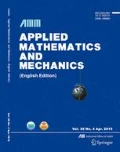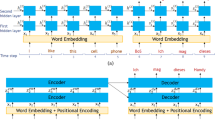Abstract
As a typical rhythmic movement, human being’s rhythmic gait movement can be generated by a central pattern generator (CPG) located in a spinal cord by self-oscillation. Some kinds of gait movements are caused by gait frequency and amplitude variances. As an important property of human being’s motion vision, the attention selection mechanism plays a vital part in the regulation of gait movement. In this paper, the CPG model is amended under the condition of attention selection on the theoretical basis of Matsuoka neural oscillators. Regulation of attention selection signal for the CPG model parameters and structure is studied, which consequentially causes the frequency and amplitude changes of gait movement output. Further, the control strategy of the CPG model gait movement under the condition of attention selection is discussed, showing that the attention selection model can regulate the output model of CPG gait movement in three different ways. The realization of regulation on the gait movement frequency and amplitude shows a variety of regulation on the CPG gait movement made by attention selection and enriches the controllability of CPG gait movement, which demonstrates potential influence in engineering applications.
Similar content being viewed by others
References
Kiehn, O. and Butt, S. J. Physiological, anatomical and genetic identification of CPG neurons in the developing mammalian spinal cord. Progress in Neurobiology, 70, 347–361 (2003)
Choi, J. T. and Bastian, A. J. Adaptation reveals independent control networks for human walking. Nature Neuroscience, 108, 1055–1062 (2007)
Marder, E. and Bucher, D, Central pattern generators and the control of rhythmic movement. Central pattern generators and the control of rhythmic movement 1123, 986–996 (2001)
Forssberg, H. and Grillner, S, The locomotion of the acute spinal cat injected with clonidine i.v. The locomotion of the acute spinal cat injected with clonidine i.v 501, 184–186 (1973)
Brown, T. G. The intrinsic factors in the act of progression in the mammal. Proceedings of the Royal Society of London Series B: Containing Papers of a Biological Character, 84572, 308–319 (1911)
Lu, Q. and Tian, J, Synchronization and stochastic resonance of the small-world neural network based on the CPG. Synchronization and stochastic resonance of the small-world neural network based on the CPG 83, 217–226 (2014)
Osamu, A, Computer simulations of synchrony and oscillations evoked by two coherent inputs. Computer simulations of synchrony and oscillations evoked by two coherent inputs 72, 133–141 (2013)
Lipinski, J., Sandamirskaya, Y., and Schöner, G, Swing it to the left, swing it to the right: enacting flexible spatial language using a neurodynamic framework. Swing it to the left, swing it to the right: enacting flexible spatial language using a neurodynamic framework 34, 373–400 (2009)
Zehr, E. P. and Duysens, J, Regulation of arm and leg movement during human locomotion. Regulation of arm and leg movement during human locomotion 104, 347–361 (2004)
Perez-Marcos, D., Sanchez-Vives, M. V., and Slater, M, Is my hand connected to my body? The impact of body continuity and arm alignment on the virtual hand illusion. Is my hand connected to my body? The impact of body continuity and arm alignment on the virtual hand illusion 64, 295–305 (2012)
Dominguez, L. G., Kostelecki, W., Wennberg, R., and Velazquez, J. L. P. Distinct dynamical patterns that distinguish willed and forced actions. Cognitive Neurodynamics, 51, 67–76 (2011)
Ogihara, N. and Yamazaki, N, Generation of human bipedal locomotion by a bio-mimetic neuromusculo- skeletal model. Generation of human bipedal locomotion by a bio-mimetic neuromusculo- skeletal model 841, 1–11 (2001)
Niebur, E. and Koch, C. A model for the neuronal implementation of selective visual attention based on temporal correlation among neurons. Journal of Computational Neuroscience, 1(1-2), 141–158 (1994)
Morris, J. S., Friston, K. J., and Dolan, R. J. Neural responses to salient visual stimuli. Processings of the Royal Society B: Biological Sciences, 2641382, 769–775 (1997)
Haken, H, Towards a unifying model of neural net activity in the visual cortex. Towards a unifying model of neural net activity in the visual cortex 11, 15–25 (2007)
Jeong, S., Arie, H., Lee, M., and Jun, T, Neuro-robotics study on integrative learning of proactive visual attention and motor behaviors. Neuro-robotics study on integrative learning of proactive visual attention and motor behaviors 61, 43–59 (2012)
Chik, D., Borisyuk, R., and Kazanovich, Y, Selective attention model with spiking elements. Selective attention model with spiking elements 22, 890–900 (2009)
Qu, J. Y., Wang, R. B., and Du, Y, An improved selective attention model considering orientation preferences. An improved selective attention model considering orientation preferences 222, 303–311 (2013)
Matsuoka, K, Sustained oscillations generated by mutually inhibiting neurons with adaptation. Sustained oscillations generated by mutually inhibiting neurons with adaptation 526, 367–376 (1985)
Matsuoka, K, Mechanisms of frequency and pattern control in the neural rhythm generators. Mechanisms of frequency and pattern control in the neural rhythm generators 56(5-6), 345–353 (1987)
Matsuoka, K, Analysis of a neural oscillator. Analysis of a neural oscillator 104(4-5), 297–304 (2011)
Taga, G., Yamaguehi, Y., and Shimizu, H, Self-organized control of bipedal locomotion by neural oscillators in unpredictable environment. Self-organized control of bipedal locomotion by neural oscillators in unpredictable environment 653, 147–159 (1991)
Taga, G. A model of the neuro-musculo-skeletal system for human locomotion. Biological Cybernetics, 732, 97–121 (1995)
Zhang, D. G., Zhu, K. Y., and Zheng, H, Model the leg cycling movements with neural oscillator. Model the leg cycling movements with neural oscillator 1, 740–744 (2004)
Zhang, D. G. and Zhu, K. Y. Computer simulation study on central pattern generator: from biology to engineering. International Journal of Neural Systems, 166, 405–422 (2006)
Zhang, D. G. and Zhu, K. Y. Modeling biological motor control for human locomotion with function electrical stimulation. Biological Cybernetics, 961, 79–97 (2007)
Dong, W., Wang, R. B., and Zhang, Z. K. Discussion on rhythmic gait movement affected by cerebral cortex signal. Advances in Cognitive Neurodynamics (II), Proceedings of the Second International Conference on Cognitive Neurodynamics, Springer-Verlag, the Netherlands, 467–471 (2011)
Dong, W., Wang, R. B., and Zhang, Z. K. Exploring human rhythmic gait movement in the role of cerebral cortex signal. Applied Mathematics and Mechanics (English Edition), 322, 223–230 (2011) DOI 10.1007/s10483-011-1408-6
Hodgkin, A. L. and Huxley, A. F. A quantitative description of membrane current and its applications to conduction and excitation in nerve. Journal of Physiology, 1174, 500–544 (1952)
Pandy, M. G. Computer modeling and simulation of human movement. Annual Review of Biomedical Engineering, 3, 245–273 (2001)
Winter, D. A. Biomechanics and Motor Control of Human Movement, 4th ed., John Wiley and Sons, Hoboken (2009)
Wang, W. and Wang R. B. The control of CPG gait movement under the condition of attention selection. Advances in Cognitive Neurodynamics (V), Proceedings of the Fifth International Conference on Cognitive Neurodynamics, Springer-Verlag, Singapore, 653–659 (2016)
Huang, P., Qi, J., Deng, L. F., and Chen, B, Surface electromyography analysis of the lower limb muscles of normal young people during natural gait. Surface electromyography analysis of the lower limb muscles of normal young people during natural gait 1620, 3680–3684 (2012)
Author information
Authors and Affiliations
Corresponding author
Additional information
Project supported by the National Natural Science Foundation of China (Nos. 11232005 and 11472104) and the Doctoral Fund of Ministry of Education of China (No. 20120074110020)
Rights and permissions
About this article
Cite this article
Wang, W., Wang, R. Control strategy of central pattern generator gait movement under condition of attention selection. Appl. Math. Mech.-Engl. Ed. 37, 957–966 (2016). https://doi.org/10.1007/s10483-016-2096-9
Received:
Revised:
Published:
Issue Date:
DOI: https://doi.org/10.1007/s10483-016-2096-9




